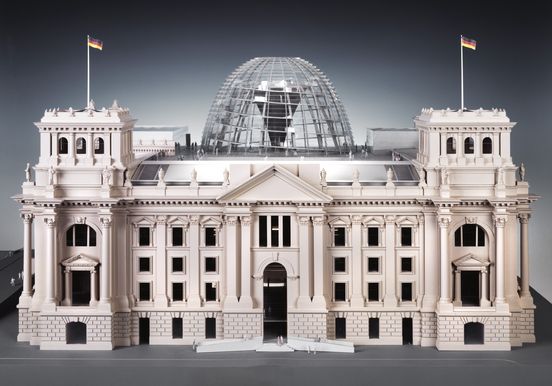The fall of the Berlin Wall and German unification triggered a construction boom in Berlin that has not yet abated. For a while the city was the biggest building site in Europe, and even if there are now fewer cranes on the skyline and many major projects have been finished, the sound of building is a simple fact of life in the city.
After 1990 there was a huge need for political buildings in Berlin. After more than 40 years apart, the two Germanies merged again to form a single country with one capital. The federal government along with parliament, the ministries and almost all the foreign diplomatic missions now moved to the new political centre. A new government district was created along the arc in the river known as the Spreebogen, and the borough of Tiergarten in particular became home to many newly built embassies, representing their nations with sometimes spectacular architecture.
![[Translate to English:] Berger+Parkkinen Architekten, The Nordic Embassies, 2001, Berlin-Tiergarten (Rauchstraße), Exterior view Photograph by Christian Richters, Inkjet Print, 73,2 x 57,9 cm](/assets/_processed_/f/b/csm_Architektur-Ausstellung-Berlin-Ralph-Hinterkeuser-Botschaften-Nordische-Laender-Tiergarten_11a9a1d1e0.jpg)
[Translate to English:] Berger+Parkkinen Architekten, The Nordic Embassies, 2001, Berlin-Tiergarten (Rauchstraße), Exterior view
© Foto: Ralph Hinterkeuser![[Translate to English:] Léon Wohlhage Wernik Architekten, Modell für das Bundesministerium für Familien, Senioren, Frauen und Jugend (BMFSFJ), 2004 Architectural model by Léon Wohlhage Wernik Architects, Wood, Plexiglas, Plastic, 6 x 17 x 13,5 cm](/assets/_processed_/f/a/csm_Architektur-Ausstellung-Berlin-L%C3%A9on-Wohlhage-Wernik-Bundesministerium-fuer-Familie-Senioren-Frauen-Jugend_e24d0f7368.jpg)
[Translate to English:] Léon Wohlhage Wernik Architekten, Modell für das Bundesministerium für Familien, Senioren, Frauen und Jugend (BMFSFJ), 2004
© Modell: Léon Wohlhage Wernik Architekten, Foto: Kai-Annett BeckerAmong the federal buildings, the Chancellery designed by Charlotte Frank and Axel Schultes and the dome over the old Reichstag by Sir Norman Foster are landmarks of the new Berlin and a popular motif for tourist snapshots. Both these projects were preceded by big architectural competitions. The heated debates about the best solutions for these emblematic buildings have long been forgotten. Only the models and documents submitted by the contestants are still here to remind us of alternative proposals.
The new Berlin has not only been defined by political buildings. New urban spaces have sprung up in the historical city centre between Potsdamer, Leipziger and Pariser Platz and around the new main station designed by Gerkan, Marg and Partners. The next construction site is only a matter of time...
